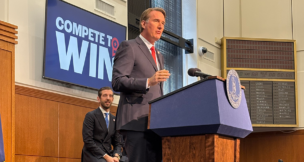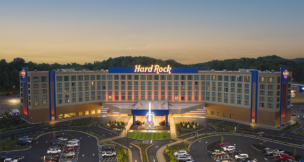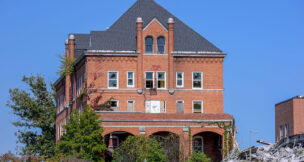Gateway gains momentum
Amazon, Rolls-Royce, ‘Lincoln’ give region a big boost
Virginia Business //January 24, 2013//
Gateway gains momentum
Amazon, Rolls-Royce, ‘Lincoln’ give region a big boost
Virginia Business //January 24, 2013//
Renee Chapline’s voice rose with excitement. “It’s like the stars have become aligned,” says Chapline, executive director of Virginia’s Gateway Region (VGA).
Think Amazon, think Rolls-Royce, think the sprawling military base of Fort Lee, think a fast track to Virginia ports, think hummus and Steven Spielberg.
Chapline has been thinking about all those things during the past year, as a wave of capital investment — and a pinch of Hollywood pixie dust — has boosted opportunity across much of the region she represents.
Virginia’s Gateway Region is an economic development entity that promotes industry and enterprise across multiple jurisdictions in an area that generally begins south of the James River near Richmond.
Chapline says recent development activity is energizing the region — more so in some areas than others, but helping to raise all boats.
The region stretches from Chesterfield County through the cities of Colonial Heights, Hopewell and Petersburg into Dinwiddie and Prince George counties, and then even further into far-reaching rural areas such as Surry and Sussex counties.
Chapline says she never could have forecast the progress the region was going to make when she came aboard in 2005 to take a leadership role in economic development.
The exclamation points in her list of economic wins include:
- The explosive growth of the Fort Lee Army base, adjoining Prince George and Petersburg, and its whale-size $2.4 billion contribution to the area’s economy;
- The construction of two mammoth Amazon distribution centers in the region within the past year, one in Chesterfield and the other in Dinwiddie;
- The establishment of a 1,000-acre Rolls-Royce aerospace campus in Prince George, and the recent announcements that the company is going to build a second manufacturing plant on the site;
- The opening of a research center for advanced manufacturing, also in Prince George;
- A proposal to fast-track construction of a new U.S. 460 toll road that would open a high-speed connection with Hampton Roads for the entire region;
- Steven Spielberg’s movie “Lincoln,” that has focused national attention on Petersburg, whose old mansions and vacant commercial buildings have been receiving renewed interest from preservationists and developers.
“It’s unlike anything we’ve ever seen,” Chapline said, speaking of the region’s sudden momentum.
Comparatively low overall unemployment in most areas has been one benefit of that momentum, though pockets of above-average unemployment, such as in Petersburg, remain high.
Led by Chesterfield at 5.3 percent, five of the eight localities in the region had unemployment rates under 7 percent in October at a time when the national jobless rate was 7.7 percent and the overall Virginia rate was 5.7 percent.
The region’s anchor is Chesterfield, one of Virginia’s mega-counties with a 2010 population of more than 316,000.
Will Davis, Chesterfield County’s economic development director, says 2012 was a banner year.
“A 148 percent increase in fiscal investment, one of the biggest years in the history of Chesterfield County,” Davis says.
That translated into nearly $355 million in new capital investment and 2,276 jobs, coming at a time when many other areas of the country were plagued by mounting layoffs and plant closures.
The charge was led by Amazon’s construction of an $85 million distribution center in the county’s 1,300-acre Meadowville Technology Park off Interstate 95 next to the James River in the eastern side of the county.
The Amazon facility is a behemoth — a million square feet under roof, an area so large a couple of aircraft carriers could fit neatly inside.
Another 1-million-square-foot Amazon distribution center went up in Dinwiddie County. The two centers will employ a total of 1,350 workers.
Capital One Financial Corp., based in McLean, has said it also will be moving into the Meadowville Park, investing $150 million in a data center employing 50 people.
Besides Amazon, another park partner is Northrop Grumman, which oversees a sizeable slice of technology services for the Commonwealth of Virginia. In 2005, when the state announced that Northrop Grumman would establish operations in Chesterfield, its initial investment was to be $125 million, with a total of $250 million over 10 years.
Hummus also is playing a bigger role in Chesterfield’s future, with a recent announcement by Sabra Dipping Co. that it will invest $28 million to expand its production plant in the county and build a 20,000-square-foot research center, creating an estimated 90 new jobs.
Davis notes that the company also is exploring the possibility of involving Virginia farmers in growing chickpeas, the primary ingredient in hummus. “Chickpeas could become a cash crop in Virginia,” he says.
Chesterfield has been aggressively bolstering its position in tourism, including sports and entertainment tourism, as well as historical destinations such as Henricus, an early English settlement on the James River where the Indian princess Pocahontas lived and met John Rolfe, whom she eventually married.
Uptown Alley, a $21 million bowling/entertainment complex, recently opened at Commonwealth Center Parkway.
Davis says that while Chesterfield has a lot going on, befitting a very large county, it considers itself a partner with the other jurisdictions in the region in economic development. “A prospect doesn’t know where a boundary line is and doesn’t really care,” Davis says, and jobs created in one area draw workers regionally.
If the Gateway Region has a colossus it would be Fort Lee, an economic powerhouse for the Tri-Cities, which encompasses Colonial Heights, Hopewell and Petersburg, and the counties that abut them.
A recent study by the University of Illinois at Chicago found that the sprawling Army base had an annual economic impact of $2.4 billion in the region.
Fort Lee has nearly doubled in size since 2005, thanks to a $1.5 billion investment that was part of the Base Realignment and Closure process, which shuttered some bases at the expense of consolidations and growth at others.
Today, Fort Lee generates more than $124 million in state and local taxes and accounts for 28,000 jobs in the region immediately surrounding it.
About 38 percent of the U.S. Army is trained at Fort Lee, now the site of the Army’s quartermaster, transportation and ordnance schools.
Percy Ashcraft, the county administrator in Prince George County, says Fort Lee’s expansion has generated revenues that helped the county to weather the economic downturn that crippled other parts of the nation. “Since 2009, we’ve received $4.2 million in contractor fees, and that’s a direct payment,” Ashcraft says.
The revenue stream created by Fort Lee, Ashcraft says, has enabled the county to build a new library, open an animal center and renovate the police station, all without contributing to the burden of local taxpayers.
Ashcraft added that Fort Lee’s growth has not strained government services or the schools, and retirees from the military installation have been assets to the community.
For Prince George County, the last several years have represented a watershed of good economic news.
In May 2011, for example, Rolls-Royce officially opened its 1,000-acre Crosspointe aerospace campus, having completed about six months earlier its first factory for producing precision-engineered engine discs and other advanced aircraft components.
The factory represents a $170 million investment and will eventually employ 150 skilled workers.
In mid-November, Rolls-Royce announced that it was planning to build a second plant on its property, this one to produce turbine blades for its engines, used on some of the world’s most advanced aircraft.
The company’s investment will total $130 million and create an additional 140 jobs. Construction of the new plant is expected to be completed by the end of next year, with the first components being produced in late 2014.
In time, Rolls-Royce has said it likely will invest a total of $500 million in its Crosspointe campus.
To serve the power needs of Rolls-Royce, Gateway Green Energy Holdings will build a $136 million gas-powered power plant in Prince George using Rolls-Royce turbine generators.
The company also has said it will develop an 8-mile pipeline to supply water to the power plant, drawing from the South-Central Wastewater Authority’s treatment facility on Pocahontas Island in Petersburg.
Abutting the Rolls-Royce campus on a 20-acre site is the recently opened Commonwealth Center for Advanced Manufacturing, a symbol of the transformation taking place in the once largely agricultural economy of Prince George County.
CCAM is a collaborative venture to develop advanced manufacturing technology through a partnership between corporate and university researchers.
During a visit prior to re-election, President Barack Obama lauded CCAM as a model for advanced manufacturing for the nation.
Currently more than a dozen companies have signed on with CCAM. The goal is to build that number to 25 to 30 during the next couple of years.
Three Virginia institutions — Virginia Tech, the University of Virginia and Virginia State University — also are in the mix to conduct research, and CCAM’s executive director, Dave Lohr, says that more educational institutions could be added later.
When legendary movie director Steven Spielberg came to the Richmond area in 2011 to film the movie “Lincoln,” he included Petersburg in his shooting schedule, and some of its buildings are prominently displayed in the movie.
Production of the movie showered tens of millions of dollars on the region and drew special attention to the Petersburg area, where Lincoln visited with Union Gen. Ulysses S. Grant at City Point (now part of Hopewell) as the Confederacy began to collapse.
Vandy Jones, Petersburg’s economic development director, says that Petersburg — a community of more than 32,000 — has been on the build in recent years, as developers using historic tax credits to offset renovation costs have readapted older buildings to new uses, such as apartments. “Since 2006, we’ve had 700-800 units come up, just into the downtown area,” Jones says.
Old tobacco buildings — Petersburg was once a bustling center for tobacco manufacturing — have been a favorite of developers.
A local newspaper, the Progress-Index, has cited a 1917 Chamber of Commerce report noting that the city was then producing an annual average of 2.1 billion cigarettes, 13.2 million cigars, 600,000 pounds of smoking tobacco and 5.5 million pounds of plug and twist chewing tobacco. The last remaining tobacco manufacturing company in the city closed in 2010.
Petersburg has been a traditional center for medical services in the region, and in recent years it has solidified that position.
In 2008, for example, Southside Regional Medical Center built a $145 million replacement hospital, at 200 Medical Park Blvd. in the city. It is building a $10 million Cancer Center, attached to the hospital.
Poplar Springs Hospital also is completing a nearly $6 million Behavioral Health Unit, specifically designed to meet the needs of military service members.
Virginia State University (VSU), a historically black institution adjacent to Petersburg, has been involved in many of the most important economic projects in the region. In addition to being a university partner in CCAM, VSU has expanded its programs and course offerings for military and civilian personnel at Fort Lee, and it has been working with Sabra Foods to determine whether chickpeas could be grown in the region for the production of hummus. “I think there is an intrinsic link between economic development and universities,” VSU President Keith Miller says.
Miller notes that in working with Fort Lee one of his goals is to keep in the region some of the military’s best and brightest minds. He also wants to help develop the best minds in area school systems. To that end, Miller says that numerous VSU honor students have volunteered in Petersburg schools to help students who might be struggling.
In 2011, Gov. Bob McDonnell awarded the Reginald F. Lewis School of Business at VSU the Governor’s Award for Technology in Innovation in Higher Education, as it became the first school in the country to deliver its core curriculum in a predominantly digital format.
With the growing presence of nearby Rolls-Royce facilities and the opening of CCAM, Miller says, “There are tremendous opportunities on the research side for our faculty,” which will enrich both the region and the university’s students.
CCAM recently announced that VSU has committed five faculty members to support the center’s research efforts in surface engineering and manufacturing systems.
One of the potentially most positive economic impacts on the region is the recently announced proposal to build a high-speed toll road through this region to Hampton Roads. The precise design and route of the road have not yet been determined.
It will be a new U.S. 460, and could carry a price tag of $1.4 billion or more. For vehicles traveling the entire 55-mile route of the road, the toll would initially be $3.69 for cars and $11.72 for trucks, with tolls gradually rising in future years.
The existing U.S. 460 would remain open for travel with no tolls. “People said a [new] 460 would never happen in their lifetime, and now it’s happening,” says Chapline, of Virginia’s Gateway Region.
With increased shipping expected through Hampton Roads with the expansion of the Panama Canal, Chapline says the Gateway Region would become a vital link in an increasingly important transportation network.
“For us, it might be the last piece of the puzzle,” she said.
i















